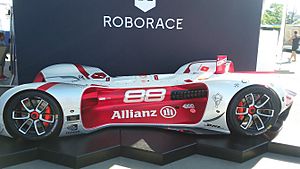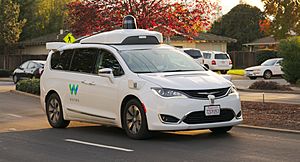Driverless car facts for kids
A self-driving car, also known as an autonomous car, driver-less car, or robotic car (robo-car), is a car that is capable of traveling without human input. Self-driving cars use sensors to perceive their surroundings, such as optical and thermographic cameras, radar, lidar, ultrasound/sonar, GPS, odometry and inertial measurement units. Control systems interpret sensory information to create a three-dimensional model of the vehicle's surroundings. Based on the model, the car then identifies an appropriate navigation path and strategies for managing traffic controls (stop signs, etc.) and obstacles.
PC Magazine defines a self-driving car as "a computer-controlled car that drives itself". The Union of Concerned Scientists states that self-driving cars are "cars or trucks in which human drivers are never required to take control to safely operate the vehicle. Also known as autonomous or "driver-less" cars, they combine sensors and software to control, navigate, and drive the vehicle."
The British Automated and Electric Vehicles Act 2018 law defines a vehicle as "driving itself" if the vehicle "is operating in a mode in which it is not being controlled, and does not need to be monitored, by an individual".
Another British definition assumes: "Self-driving vehicles are vehicles that can safely and lawfully drive themselves."
Contents
History
Experiments have been conducted on automated driving systems (ADS) since at least the 1920s; trials began in the 1950s. The first semi-automated car was developed in 1977, by Japan's Tsukuba Mechanical Engineering Laboratory, which required specially marked streets that were interpreted by two cameras on the vehicle and an analog computer. The vehicle reached speeds up to 30 kilometres per hour (19 mph) with the support of an elevated rail.
A landmark autonomous car appeared in the 1980s. In recent years, such automakers as Honda, Tesla, Mercedes-Benz, and others have been working on new models of autonomous cars.
As of 2021, self-driving cars have been used in controlled envirnoments more and more. An example of this might be buses that transfer passengers between airport terminals.
Types of self-driving cars
Autonomy in vehicles is often divided into six levels, according to a system developed by SAE International (SAE J3016). The SAE levels can be roughly understood as Level 0 – no automation; Level 1 – hands on/shared control; Level 2 – hands off; Level 3 – eyes off; Level 4 – mind off, and Level 5 – steering wheel optional.
Applications
Robotaxi
Robotaxi is supposed to be operated by taxi company or ridesharing company. Through the massive investments by Big Tech companies in the mid-2010s, research and development of robotaxi became active in the U.S.
Self-driving shuttle and bus
Self-driving shuttle is used mainly in cities. Through the European Union funded "CityMobil2" project in the mid-2010s, research and development of self-driving shuttle became active in Europe. Continuously, under the funding programme Horizon 2020, "Avenue" project was conducted from 2018 to 2022 in four cities (Geneva, Lyon, Copenhagen and Luxembourg).
Self-driving truck and van
Companies such as Otto and Starsky Robotics have focused on autonomous trucks. Automation of trucks is important, not only due to the improved safety aspects of these very heavy vehicles, but also due to the ability of fuel savings through platooning. Autonomous vans are being developed for use by online grocers such as Ocado.
Autonomous micro-mobility
Research has indicated that goods distribution on the macro (urban distribution) and micro level (last mile delivery) could be made more efficient with the use of autonomous vehicles thanks to the possibility of smaller vehicle sizes. Also, simulation studies in MIT Media Lab indicate that ultra-lightweight systems can become more helping to remove cars from our cities by applying autonomous driving technologies.
In November 2022, Honda unveiled the "Honda CI Micro-mobility" machines and their core technologies. Honda starts demonstration testing using "Honda CI Micro-mobility" machines, "CiKoMa" and "WaPOCH", at two locations in Jōsō City of Ibaraki Prefecture.
Autonomous work vehicle
In 2021, Honda and Black & Veatch have successfully tested their second generation prototype Autonomous Work Vehicle (AWV) at a Black & Veatch construction site in New Mexico.
In December 2022, eve autonomy in Japan, a company backed by Yamaha Motor and TIER IV, launched the all-in-one autonomous transportation commercial service "eve auto" with EV work vehicle as the first SAE Level 4 service in Japan at nine sites, including Yamaha Motor's three factories, Prime Polymer's Anesaki Works, Panasonic's cold chain factory in the Oizumi area, Fuji Electric's Suzuka factory, Japan Logistic Systems Corp.'s Ageo Center, and ENEOS Corp.'s Negishi refinery.
Advantages of self-driving cars
Self-driving cars have a number of advantages. Once the technology matures, it will positively impact the automotive industry, health, welfare, urban planning, traffic, insurance, labor market, and other fields.
People with disabilities and those who can't drive due to their age can use self-driving taxis to get where they need to. Such vehicles can also help reduce road accidents thanks to preinstalled automated driver assistance systems.
For transport companies self-driving trucks are more efficient because they can run for longer periods of time without needing to stop for meals.
Concerns
Mass production and use of self-driving cars can lead to numerous problems. How the car would deal with potentially dangerous situations? How many people currently employed as drivers would become unemployed? Will the car's AI be able to understand verbal sounds, gestures and non-verbal cues by police, other drivers or pedestrians correctly? In addition, cyberattacks could also be a potential threat to autonomous driving in the future.
Privacy-related issues also arise as automated cars are interconnected. This makes them just another mobile device that can gather any information about an individual, like tracking of the routes taken, voice recording, video recording, preferences in media that is consumed in the car, behavioral patterns, etc.
Besides, a nation's road network must be upgraded in order to accommodate autonomous cars. New standards, approaches and legislation are yet to be created.
The Trolley Problem
This is moral dilemma that a software engineer or car manufacturer might face in programming the operating software of a self-driving vehicle.
The situation is as follows. An autonomous vehicle is driving with passengers when suddenly a person appears in its way and the car has to choose between one of two options, either to run the person over or to avoid hitting the person by swerving into a wall, killing the passengers. Which option is more preferable?
According to research, people agree to the idea that self-driving cars should be programmed to stick to the option that generates the least harm and minimizes driving casualties. However, those who would like to buy such a vehicle for themselves, they prefer to ride in vehicles that prioritize the lives of people inside the vehicle at all costs. This presents a paradox.
Public opinion surveys
In a 2011 online survey of 2,006 US and UK consumers by Accenture, 49% said they would be comfortable using a "driverless car".
In 2019, results from two opinion surveys of 54 and 187 US adults respectively were published. Results showed that users were less accepting of high autonomy levels and displayed significantly lower intention to use highly autonomous vehicles. Additionally, partial autonomy (regardless of level) was perceived as requiring uniformly higher driver engagement (usage of hands, feet and eyes) than full autonomy.
In 2022, research by safety charity Lloyd's Register Foundation uncovered that only a quarter (27%) of the world's population would feel safe in self-driving cars.
Waymo
Waymo originated as a self-driving car project within Google. In August 2012, Google announced that their vehicles had completed over 300,000 automated-driving miles (500,000 km) accident-free, typically involving about a dozen cars on the road at any given time, and that they were starting to test with single drivers instead of in pairs. In late-May 2014, Google revealed a new prototype that had no steering wheel, gas pedal, or brake pedal, and was fully automated. As of March 2016[update], Google had test-driven their fleet in automated mode a total of 1,500,000 mi (2,400,000 km). In December 2016, Google Corporation announced that its technology would be spun off to a new company called Waymo, with both Google and Waymo becoming subsidiaries of a new parent company called Alphabet.
According to Google's accident reports as of early 2016, their test cars had been involved in 14 collisions, of which other drivers were at fault 13 times, although in 2016 the car's software caused a crash.
Images for kids
-
A prototype of Waymo's self-driving car, navigating public streets in Mountain View, California in 2017
See also
 In Spanish: Vehículo autónomo para niños
In Spanish: Vehículo autónomo para niños







